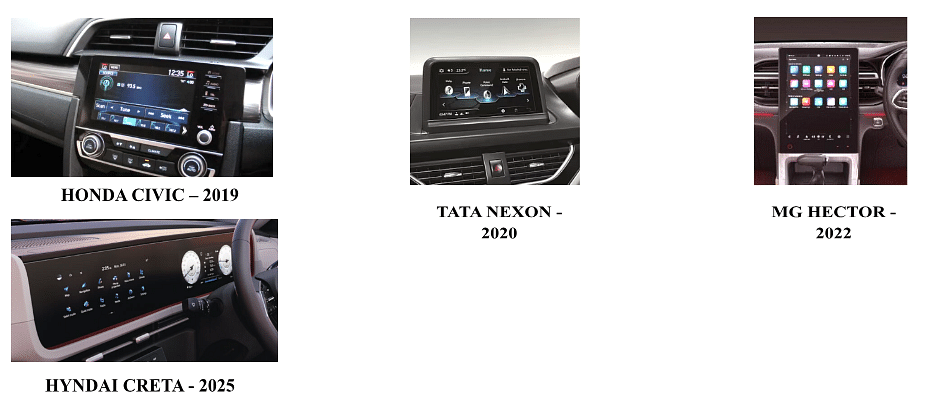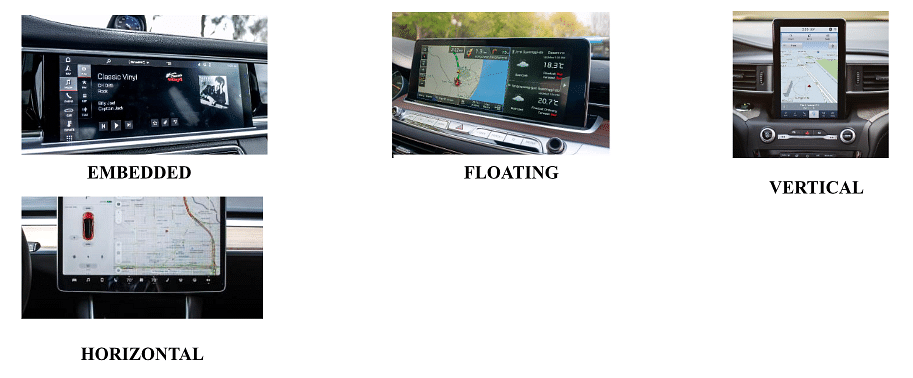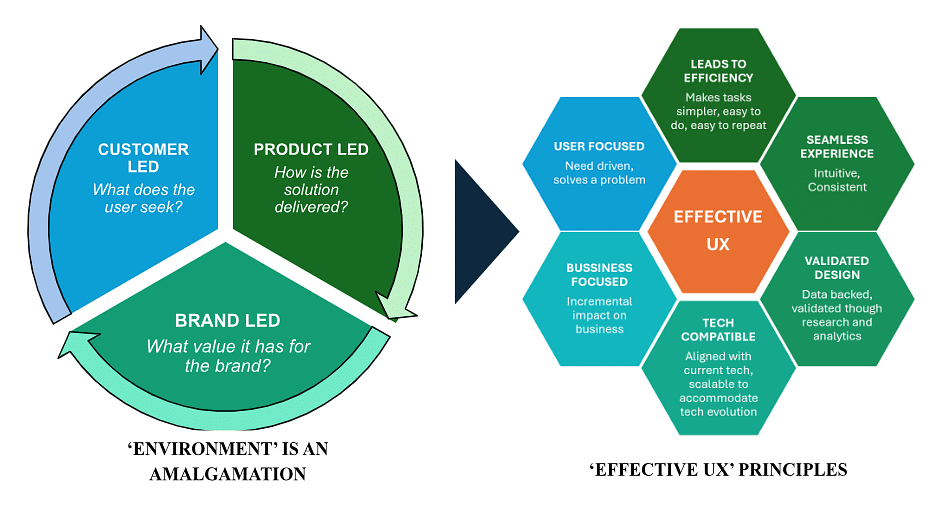Role of User Experience (UX) Amid “Screenification” in Automobiles
Passenger vehicles are entering a new digital era with larger, smarter, and multiple in-car screens, transforming driving into a tech-enabled experience that prioritizes user engagement, design innovation, and personalized, AI-powered functionality.
As a young kid, I remember the days of having an in-built radio in grandfather’s car. Or a few years later, seeing a simple SONY music player in Dad’s car. For that time, these were fancy experiences for me. Looking back, honestly, there was nothing much to ‘use’ and just a limited, bare minimum experience with hardware – some buttons and knobs at best. The interaction with tech – limited!
The game has changed now and how! A strong wave of ‘Screenification’ in passenger cars is now evident, becoming the centre piece for delivering ‘experience’ and driving values. Brands now strive to own these values through screens – Futuristic, Tech Advanced, Innovative, Customer Centric and now – AI enabled.
1. Screens are getting bigger, better
 For the longest time, 5” – 7” inch screens dominated in the Indian market - car owners enjoyed having a screen with basic information. Screen mirroring started with limited functionality, navigation being the prime usage.
For the longest time, 5” – 7” inch screens dominated in the Indian market - car owners enjoyed having a screen with basic information. Screen mirroring started with limited functionality, navigation being the prime usage.
Then started an in-flow of >10” inch screens, still prevalent as premium offering. These larger screens enabled Screen-split/ Active tiles– Active navigation, control music, etc. from home screen.
Bigger screens allowed for a clean, clutter free look, scope for customization & access to multiple features – Device connectivity, audio adjustments, message/ call display, etc. Not to forget - Futuristic feel – no physical buttons!
Moreover, screens got better in terms of resolution and display quality. Though TFT screens are currently ruling the roost, OEMs are delivering LED, OLED, curved displays for vivid, sharper and fluid graphics in top end variants, delivering a luxurious experience.
With latest models now offering screens > 13” inches, embedded/ floating on the dashboards - this space is sure to explode and take a coveted centre spot by driving user experience in passenger car segment.
2. Creating differentiation through screen “format”

Few years back, placement of the screen was a no-brainer. Almost every OEM did it the same way. Then to create a differentiation, things started changing and screen setup started evolving and now we have multiple layouts – Embedded, Floating, Horizontal, Vertical!
MG Hector created a buzz in the Indian market with a unique large, vertical display, breaking the mould of standard embedded/ floating horizontal displays. It is still a stand-out feature for the Hector.
Bharat Mobility 2025 showcased innovation across OEMs. The BYD Seal (2025) showcased in the Expo boasted of an infotainment screen which can rotate! With a click of an on-screen button you can choose if you want the screen to be horizontal or vertical!

3. ‘multi-screen’ is set to be a gamechanger, for real!
 World is now moving beyond conventional single screen to multi-screen. Currently, Indian market is sporting ‘monolith’ screens – The new Hyundai Creta, Kia Seltos, Mahindra XUV 700 are prime examples. They have set the tone for other OEMs and moreover, aspirations for new car buyers.
World is now moving beyond conventional single screen to multi-screen. Currently, Indian market is sporting ‘monolith’ screens – The new Hyundai Creta, Kia Seltos, Mahindra XUV 700 are prime examples. They have set the tone for other OEMs and moreover, aspirations for new car buyers.
Leading auto brands – Mercedes Benz, BMW, etc. are all boasting of how multi-screens/ ‘hyper screens’ are driving ‘In-car-environment’. Imagine dedicated screens in front row, +2nd/ 3rd rows driving media/ content consumption and playing a critical role in enhancing overall trip quality, providing immersive experience and higher engagement for all passengers.
A multi-screen ‘environment’ also opens a new dimension of opportunities for ‘personalised / car specific content’ or equipped with AI capabilities, pave the way for targeted marketing (Imagine a “Best places to eat” on-screen recommendation while on a road trip!).
As driver critical information, convenience, and entertainment remain key central ideas for multi-screen ecosystem, OEMs are experimenting varied use cases. Few ‘out-of-the-box’ examples are ORVMs replaced with a screen! (Honda-e concept, Lexus ES Takumi) and on-screen sliders for climate-control (VW ID.7).
 Prima-facie it seems a simple adoption for all OEMs – only increasing the number of screens in the car, right? No. These simple looking solutions are complex. Very complex.
Prima-facie it seems a simple adoption for all OEMs – only increasing the number of screens in the car, right? No. These simple looking solutions are complex. Very complex.
To break it down for the readers, a single screen currently handles Navigation, Voice controls, Media Playback, Smartphone mirroring, Hardware control (Speakers, volume, etc.), Vehicle health monitoring, Connectivity services, etc.
Complexities will increase with some developments and implementations which are around the corner:
- AI enabled navigation (curate playlists, show route recommendations, predict driver behaviour, etc.)
- Gesture/ eye control (Manage media, accept/ reject calls, etc.)
- Biometric authentication (Safety, personalised settings, etc.)
- Augmented/ Virtual Reality (Entertainment, information consumption)
- Advanced vehicle settings
- Productivity Applications (Work environment in car – MS Teams/ Zoom video calls)
- Vehicle-to-Everything (V2X)
The Hurdles and the Questions
For sure, with ‘screenification’, human-screen interaction & engagement is bound to increase. That lands us to a series of interesting questions:
- Won’t driver attention be compromised with so many screens?
- How much control will be with the driver vs. passengers?
- What about data privacy, vehicle safety, security and regulatory compliances?
- Will it be easy/ intuitive to use so many screens for everyone, alike?
- What features will the screens allow for – AV content? Gaming? Online shopping? Video/ conference calls? Everything that tablet/ iPad can do?
- What about integration across multiple devices, accounts, platforms, updates, upward/ downward compatibility in the age of quick tech obsoletion?
- Is it even required? How much will this cost?
The questions can go on, the possibilities are endless, and solutions, complex!
If the ‘multi-screen’/ ‘hyper screen’ environment works, great! And for that to work it all boils down to the seamless, intuitive usability. If it works, OEMs will create an ‘environment’ through ‘experience’. And this is where, “user experience” comes into picture. Albeit a picture behind the screens!
Creating an ‘environment’ is an amalgamation of 3 key things and needs to fit into the principles of User Experience and Design parameters:

Application of UX principles in ‘screenification’ becomes critical as the industry takes faster and firmer strides in implementation. It is not a phenomenon which can be taken from one market and applied in another. It needs to be thought through and tailored to solve problems unique to the market while making business sense.
If we imagine ‘screenification’ for India passenger car market, an OEM implementing it must answer a few basic questions:
1) User focused: Automobile research in India is focused on listening majorly to the main owner/ driver of the car. Focus on listening to passengers/ other family members is non-existent. Going ahead, the key will be to understand the context, needs of the car user AND the passengers in the car.
- Customer (Driver + Passenger/ Other passengers) needs – Current, latent needs
- Need gaps, problem areas, pain point, wish-list
- Triggers/ barriers of usage
2) Business focused: Indian customers seek VFM in mass segment and distinction in premium/ luxury segment. The challenge for an OEM is to identify a balance between user needs and business practicalities. These could be:
- Willingness to pay ‘premium’ (E.g.: Will car owners pay extra for the monolith screen/ LED Screen/ Screens for co-passenger?)
- Aspirational image of product through ‘varianting’ (E.g.: Single screens in base variants Vs. multiple screens in top variants)
- Product “premiumization” package (E.g.: Provide screen addition as accessory for co-passengers in 2nd / 3rd row)
3) Delivering efficiency: The car usage setup in India is a mixed bag. Variables such as single vs. multi-car households, nuclear vs. joint families create a different level of complexity and interesting problems to be solved:
- UI which can be managed by elders in the household – simple, intuitive.
- Screen operation is simple, easy to explain, demonstrate?
- Is it easy to remember? (No re-demonstration/ re-explanation)
4) Seamless Experience and Tech Compatibility: Delivering a seamless experience is based on quality of fitments and compatibility with latest available tech (e.g. 5G). In regions with patchy/ no internet, the set of challenges are unique:
- For streaming AV content, how does an OEM provide seamless experience in patchy networks?
- For a work-related AV call (Teams/ Zoom), can the experience be enhanced by managing bandwidth allocation to/from other screens?
- What kind of hardware will lead to a seamless, consistent experience?
5) Validated by Research: Fortunately, research agencies can test almost everything under the sun (well, almost!). As a country united by its diversity, design and experience benchmarks in India vary across regions. Something which is flashy might be preferred in one region but completely rejected in another. Few examples to check might be:
- Is the design/ experience validated across regions?
- All screens are compatible with regional languages and tonalities for voice-operated features?
The ‘screenification’ in passenger car industry is inevitable. Driving screenification for a positive, long-lasting impact through User Experience (UX) validation is a wise decision to ensure the right fitment, given the complexities.
The larger question remains. Are OEMs willing to go that extra mile? Can they step out of the boundaries of conventional research, embrace UX research for a deeper understanding and implementation?
Some OEMs are already on the way to delivering ‘experience’. And then there are some who are just selling cars.
Piyush Mungle is Associate Director, Innovation at Ipsos India. Views expressed are the author's personal.
RELATED ARTICLES
The Advent of Connected Vehicles: eSIM Technology and Enhanced Security
India’s automotive industry accelerates toward a connected future with eSIM and C-V2X technologies, as 5G, data protecti...
India’s EV future depends on building, not buying, Battery Management Systems
India’s EV sector is gaining pace, but true progress hinges on locally made Battery Management Systems—crucial for cost,...
Roadmap Savings: Everything You Need to Know – PHYD Car Insurance
Pay-How-You-Drive (PHYD) car insurance uses telematics to offer personalized premiums based on driving behavior, promoti...





 04 Jun 2025
04 Jun 2025
 2230 Views
2230 Views





 Sarthak Mahajan
Sarthak Mahajan




